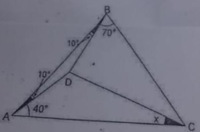You are using an out of date browser. It may not display this or other websites correctly.
You should upgrade or use an alternative browser.
You should upgrade or use an alternative browser.
In the figure below, how do I find the value of the variable?
- Thread starter ns.19
- Start date
I've tried, but, I couldn't solve this problemWho says you are wrong? Have you yet used the fact that Triangle BDA is isosceles? That may lead somewhere.
Steven G
Elite Member
- Joined
- Dec 30, 2014
- Messages
- 14,603
If you show us your work then we can see if and where you are wrong? Please post your work as the forum guidelines request.
For the record I too get an infinite solution. I of course looked at BDA being isosceles but that did not help.
I recall a similar problem like this where Dr Peterson showed that there is a unique solution. If there is one I am sure that someone will point this out and state why. Meanwhile keep trying.
For the record I too get an infinite solution. I of course looked at BDA being isosceles but that did not help.
I recall a similar problem like this where Dr Peterson showed that there is a unique solution. If there is one I am sure that someone will point this out and state why. Meanwhile keep trying.
Right. First do: measure the angle ADC = d, measure the angle BDC = z and measure the angle BCD = y. Then, using the sum of the internal angles theorem in triangle ABC, we conclude that x + y = 50, using the same theorem in triangle BDC, we conclude that z + y = 110, using the same theorem in triangle ADC, d + x = 140. Finally, looking at the figure we have 160 + d + z = 360, that is d + z = 200. Setting up the linear system with this information, we can see that such a system has infinite solutions.
Steven G
Elite Member
- Joined
- Dec 30, 2014
- Messages
- 14,603
Yes, that is just what I got, just with different lettering. I agree that the system you came up with does not have a solution. However what you have is more than just a system of equations, you have a geometric figure that can influence things. For example, d, z and y can't be negative. Possibly there is something else which we are missing that can make this problem uniquely solvable.Right. First do: measure the angle ADC = d, measure the angle BDC = z and measure the angle BCD = y. Then, using the sum of the internal angles theorem in triangle ABC, we conclude that x + y = 50, using the same theorem in triangle BDC, we conclude that z + y = 110, using the same theorem in triangle ADC, d + x = 140. Finally, looking at the figure we have 160 + d + z = 360, that is d + z = 200. Setting up the linear system with this information, we can see that such a system has infinite solutions.
lev888
Elite Member
- Joined
- Jan 16, 2018
- Messages
- 2,993
I think there is a unique solution (by construction?): ABC has angles 50, 50, 80. Point D is uniquely defined by the 10 degree angles. Therefore angle x is uniquely defined.Yes, that is just what I got, just with different lettering. I agree that the system you came up with does not have a solution. However what you have is more than just a system of equations, you have a geometric figure that can influence things. For example, d, z and y can't be negative. Possibly there is something else which we are missing that can make this problem uniquely solvable.
If you drop heights from D to AC and AB and make |AB| = 1 you can calculate everything using sin and cos of known angles. There is probably an easier way to do it.
Steven G
Elite Member
- Joined
- Dec 30, 2014
- Messages
- 14,603
I am not saying that you did not supply all the information. I am saying that possibly we are missing something that is a result of what you gave us.I understand, but, this question was passed on to me only in this way. Without any more information.
Steven G
Elite Member
- Joined
- Dec 30, 2014
- Messages
- 14,603
Nicely done! I am embarrassed at how poorly I do with geometry. I really have no talent in this subject. Your method was so obvious. Thanks for pointing it out to me and the OP and increasing my geometry maturity!I think there is a unique solution (by construction?): ABC has angles 50, 50, 80. Point D is uniquely defined by the 10 degree angles. Therefore angle x is uniquely defined.
If you drop heights from D to AC and AB and make |AB| = 1 you can calculate everything using sin and cos of known angles. There is probably an easier way to do it.

